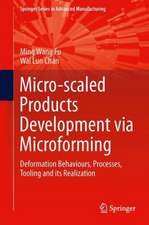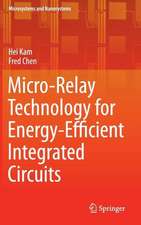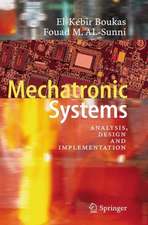Applied Scanning Probe Methods III: Characterization: NanoScience and Technology
Editat de Bharat Bhushan, Harald Fuchsen Limba Engleză Hardback – 22 feb 2006
| Toate formatele și edițiile | Preț | Express |
|---|---|---|
| Paperback (1) | 586.34 lei 39-44 zile | |
| Springer Berlin, Heidelberg – 12 feb 2010 | 586.34 lei 39-44 zile | |
| Hardback (1) | 954.93 lei 6-8 săpt. | |
| Springer Berlin, Heidelberg – 22 feb 2006 | 954.93 lei 6-8 săpt. |
Din seria NanoScience and Technology
- 24%
 Preț: 905.79 lei
Preț: 905.79 lei - 18%
 Preț: 1123.35 lei
Preț: 1123.35 lei - 18%
 Preț: 964.71 lei
Preț: 964.71 lei - 18%
 Preț: 1121.76 lei
Preț: 1121.76 lei - 15%
 Preț: 655.60 lei
Preț: 655.60 lei - 18%
 Preț: 1390.11 lei
Preț: 1390.11 lei - 18%
 Preț: 954.31 lei
Preț: 954.31 lei - 15%
 Preț: 645.79 lei
Preț: 645.79 lei - 18%
 Preț: 953.03 lei
Preț: 953.03 lei - 18%
 Preț: 945.79 lei
Preț: 945.79 lei - 15%
 Preț: 639.90 lei
Preț: 639.90 lei - 18%
 Preț: 1109.16 lei
Preț: 1109.16 lei - 23%
 Preț: 779.87 lei
Preț: 779.87 lei - 18%
 Preț: 944.99 lei
Preț: 944.99 lei - 18%
 Preț: 957.62 lei
Preț: 957.62 lei - 18%
 Preț: 971.01 lei
Preț: 971.01 lei - 18%
 Preț: 1232.26 lei
Preț: 1232.26 lei - 18%
 Preț: 960.30 lei
Preț: 960.30 lei - 15%
 Preț: 646.62 lei
Preț: 646.62 lei - 18%
 Preț: 1249.31 lei
Preț: 1249.31 lei - 15%
 Preț: 636.80 lei
Preț: 636.80 lei - 18%
 Preț: 1232.26 lei
Preț: 1232.26 lei - 24%
 Preț: 821.43 lei
Preț: 821.43 lei - 18%
 Preț: 948.92 lei
Preț: 948.92 lei - 24%
 Preț: 1827.89 lei
Preț: 1827.89 lei - 18%
 Preț: 951.91 lei
Preț: 951.91 lei - 24%
 Preț: 794.21 lei
Preț: 794.21 lei - 18%
 Preț: 953.03 lei
Preț: 953.03 lei - 23%
 Preț: 782.55 lei
Preț: 782.55 lei - 18%
 Preț: 952.57 lei
Preț: 952.57 lei - 18%
 Preț: 948.16 lei
Preț: 948.16 lei - 24%
 Preț: 809.40 lei
Preț: 809.40 lei - 23%
 Preț: 781.25 lei
Preț: 781.25 lei - 18%
 Preț: 954.93 lei
Preț: 954.93 lei - 18%
 Preț: 1830.34 lei
Preț: 1830.34 lei - 15%
 Preț: 641.71 lei
Preț: 641.71 lei - 18%
 Preț: 1228.96 lei
Preț: 1228.96 lei - 18%
 Preț: 1120.37 lei
Preț: 1120.37 lei - 18%
 Preț: 956.81 lei
Preț: 956.81 lei - 15%
 Preț: 592.59 lei
Preț: 592.59 lei - 18%
 Preț: 953.65 lei
Preț: 953.65 lei - 18%
 Preț: 954.62 lei
Preț: 954.62 lei - 18%
 Preț: 955.25 lei
Preț: 955.25 lei - 18%
 Preț: 959.19 lei
Preț: 959.19 lei - 18%
 Preț: 953.35 lei
Preț: 953.35 lei - 18%
 Preț: 786.84 lei
Preț: 786.84 lei
Preț: 954.93 lei
Preț vechi: 1164.56 lei
-18% Nou
Puncte Express: 1432
Preț estimativ în valută:
182.73€ • 195.40$ • 152.35£
182.73€ • 195.40$ • 152.35£
Carte tipărită la comandă
Livrare economică 17 aprilie-01 mai
Preluare comenzi: 021 569.72.76
Specificații
ISBN-13: 9783540269090
ISBN-10: 3540269096
Pagini: 424
Ilustrații: XLIV, 378 p. 270 illus., 2 illus. in color.
Dimensiuni: 155 x 235 x 28 mm
Greutate: 0.72 kg
Ediția:2006
Editura: Springer Berlin, Heidelberg
Colecția Springer
Seria NanoScience and Technology
Locul publicării:Berlin, Heidelberg, Germany
ISBN-10: 3540269096
Pagini: 424
Ilustrații: XLIV, 378 p. 270 illus., 2 illus. in color.
Dimensiuni: 155 x 235 x 28 mm
Greutate: 0.72 kg
Ediția:2006
Editura: Springer Berlin, Heidelberg
Colecția Springer
Seria NanoScience and Technology
Locul publicării:Berlin, Heidelberg, Germany
Public țintă
Professional/practitionerCuprins
Atomic Force Microscopy in Nanomedicine.- Scanning Probe Microscopy: From Living Cells to the Subatomic Range.- Surface Characterization and Adhesion and Friction Properties of Hydrophobic Leaf Surfaces and Nanopatterned Polymers for Superhydrophobic Surfaces.- Probing Macromolecular Dynamics and the Influence of Finite Size Effects.- Investigation of Organic Supramolecules by Scanning Probe Microscopy in Ultra-High Vacuum.- One- and Two-Dimensional Systems: Scanning Tunneling Microscopy and Spectroscopy of Organic and Inorganic Structures.- Scanning Probe Microscopy Applied to Ferroelectric Materials.- Morphological and Tribological Characterization of Rough Surfaces by Atomic Force Microscopy.- AFM Applications for Contact and Wear Simulation.- AFM Applications for Analysis of Fullerene-Like Nanoparticles.- Scanning Probe Methods in the Magnetic Tape Industry.
Recenzii
From the reviews:
"The editors have done a good job in making the various chapters quite readable and most of the chapters are well written on a level that will be accessible to most readers. … As is usually the case with Springer books, these volumes have been beautifully printed, illustrated, and nicely bound for long term durability." (Gary J. Long & Fernande Grandjean, Physicalia Magazine, Vol. 29 (4), 2007
"The editors have done a good job in making the various chapters quite readable and most of the chapters are well written on a level that will be accessible to most readers. … As is usually the case with Springer books, these volumes have been beautifully printed, illustrated, and nicely bound for long term durability." (Gary J. Long & Fernande Grandjean, Physicalia Magazine, Vol. 29 (4), 2007
Caracteristici
First book summarizing the state of the art of this technique Real industrial applications included Includes supplementary material: sn.pub/extras


























